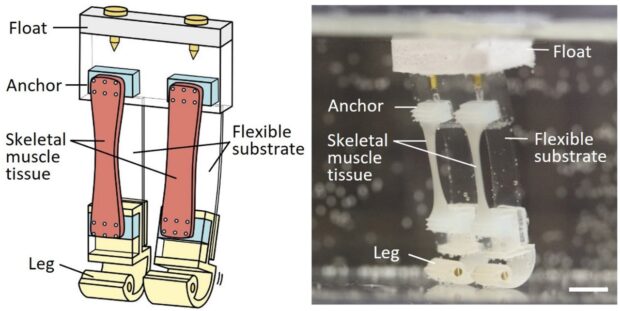Bipedal robot walks with living muscle tissue
University of Tokyo researchers created a new bipedal robot that runs with living muscle tissue. This unique component enables the machine to walk on two legs and make sharp turns to avoid obstacles. Moreover, the living tissue enables it to crawl and swim like humans. As a result, it may help future robots perform more human-like activities more efficiently.
Tesla and other tech firms want to bring humanoid robots into more industries, but they should become more flexible than existing models. For example, Tesla could bring us humanoid household bots, but they should be able to turn their bodies less than 90° to navigate homes. Fortunately, this bipedal bot might be the right step toward a solution.
How does this bipedal robot work?

At the University of Tokyo, researcher Shoji Takeuchi and his team have engineered a bipedal robot that stands out for its agility. It features a foam buoy top, enabling it to float in water, while its weighted legs ensure it maintains an upright posture.
The skeleton was silicone rubber, making it flexible and easy to bend. More importantly, they attached lab-grown skeletal muscle tissue to the silicone rubber on each leg.
This organic tissue replaced the actuators in conventional robot designs. Actuators respond to electric signals, so the scientists used those on the muscle tissue.
The organic material contracted in response to electric stimulation, lifting the robot’s leg. In contrast, the heel lands forward when the signal stops.
Eventually, they discovered alternating currents between the two legs every five seconds, simulating a “walking” movement. However, EurekAlert said the bot was extremely slow.
The bipedal robot only traveled 5.4 millimeters per minute, equivalent to 0.002 miles an hour. Fortunately, the experts made the machine perform a 90° turn by zapping only one leg repeatedly every five seconds.
The other leg functioned as an anchor as the turn took over a minute to complete. Nevertheless, the machine demonstrated that muscle-driven robots could walk, stop, and manage fine turns.
You may also like: Scientists create muscles for robots
“Currently, we are manually moving a pair of electrodes to apply an electric field individually to the legs, which takes time,” says study author Shoji Takeuchi. “In the future, by integrating the electrodes into the robot, we expect to increase the speed more efficiently.”
The team plans to add joints and thicker muscle tissues to their next bipedal robot to perform more sophisticated and powerful movements. Also, they will integrate a nutrient supply system to sustain the tissues for extended activities.
“Though they might seem like small steps, they are, in fact, giant leaps forward for the biohybrid robots,” says Takeuchi.
Another cool robot innovation
Another Japanese invention is pushing the boundaries towards a sci-fi future with its latest invention. Tokyo-based company TechMagic introduced the world’s first cooking robot and showcased it at this year’s Consumer Electronics Show (CES).
Dubbed the I-Robo, it cooks any meal from its touchscreen menu. The latter cloud-based recipe library that lets you choose from professional chefs worldwide.
“Its smart algorithms offer unique, customizable dishes, meeting the demands of contemporary culinary enthusiasts and enhancing dining experiences,” TechMagic says.
The machine can also understand and execute commands to season, stir, heat, and clean its cooking utensil. It also has an “automatic liquid seasoning supply function.”
You may also like: Japan unveils 15-foot-tall transforming robot
The I-Robo cooking robot offers a high degree of customization, allowing users to adjust the heating temperature, cooking time, rotation direction, and speed of the pan. “All that the user needs to do is tap on the menu of their choice on the touch panel, and I-Robo will do the cooking process for you,” explains the product description.
“Our robots are engineered to handle various cooking tasks such as boiling, stir-frying, and frying,” TechMagic founder Yuji Shiraki said. “In Japan, they have already been operational and have successfully prepared over 100,000 meals in the last half year.”
“We plan to introduce the I-Robo to the US market with the hopes of solving various issues surrounding the food industry globally,” he added. The TechMagic website says the cooking robot can cook 30 meals per hour. Read more about it in this other Inquirer Tech article.
Conclusion
Tokyo researchers created a bipedal robot that can perform sharp turns. Its legs are made of living tissue, providing greater flexibility than similar machines.
“Using muscle as actuators allows us to build a compact robot and achieve efficient, silent movements with a soft touch,” said researcher Shoji Takeuchi.
Learn more about this bipedal robot research paper on Matter. Moreover, check the latest digital tips and trends at Inquirer Tech.